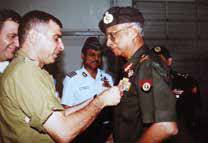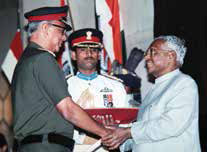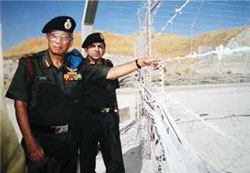
Does the corporate citizen know what a bayonet is? It is a lethal blade. Soldiers carry it slung to their belts. They use it for cutting through the underbrush in forests, carving meat, hacking at reptiles, building huts and bridges in remote areas and sundry other jobs. But it is primarily meant for use against the enemy in close combat. Clamped to the front end of his rifle, this blade becomes the soldier’s sole weapon other than his body when handto- hand combat begins. It is at this stage that full throated battle cries of “Jai Mata Di”, “Jai Gorkhali” and “Jai Bajrang Bali” reverberate as he engages in mortal combat. Mortal combat and the supreme sacrifice!!
There is a view that frequently finds expression from the political leadership, the bureaucracy and some sections of society that the armed forces comprise of volunteers who knew what they were getting into, so why should they now make a big deal of service conditions and seek better pay and perks. They are more wrong than right. Admittedly, the majority join the armed forces in search of a livelihood. But that does not necessarily mean service beyond the call of duty. And serious combat in war or in counter terrorism is only about taking risks, exposing yourself or your comrades or your subordinates to death or injury. It is high morale, motivation and a willingness to pay the ultimate price that counts in battle and not the rule-book or the defence accounts paycheck. These critics forget that there are good armies and bad armies, armies that believe in valour, honour and the glory of the nation, and armies that just draw their pay and don’t deliver. Most citizens in India do not really understand the military ethic, its code and the unwritten compact of the sailor, soldier and airman with his organisation and the nation.

Reverting back to the corporate citizen and the military: Most corporate citizens do know that many of their management structures, practices and products have been adapted from the Armed Forces. This process began with the advent of the industrial revolution and continued well after the Second World War. Thereafter, it has been a two-way traffic, both learning and adapting from each other’s tools and best practices. The examples are many: guided missiles to driverless cars, satellites for surveillance and mapping to the GPS, or for instance, drones that are being explored for mind boggling commercial applications. It is conjectured that “swarm” drones will be the next game changer on the battlefield. And it is equally likely some other type of drone might take the commercial world by storm. We share the quest for new technologies, their applications and management practices that must keep evolving for maximum exploitation in war or in business

Maximising team motivation is an important goal for leaders of both the corporate sector and the Armed Forces. The transformations that digitization and the information age are bringing about throw up fresh challenges on a daily basis that demand capacities for dynamic adaptation and evolution. It is here that the corporate citizen is perhaps ahead of his counterparts in the military. The Armed Forces have to make a special effort to acquire the required flexibility and willingness to change and stay ahead of the curve. Better interface with the corporate world can be a big facilitator. Take logistics, there is much that the military can learn from Amazon, Flipkart or Walmart. Such interaction can also contribute towards honing of the sixth and seventh senses -- so vital for success in the competitive and complex world that we live in.
Many of the management practices are common to both the corporate citizen and the military. But what the corporate citizen is unaware of perhaps is the specifics of what the military does to prepare for war both conventional and asymmetric, and the counter-insurgency/terrorism operations that it has been fighting for many decades. Besides gruelling training rigour, it places great emphasis on physical and moral courage. It focuses on tradition, “Izzat”, history, bonding, camaraderie and loyalty. Preparing soldiers to willingly accept extreme and unimaginable hardships and keep them motivated for the supreme sacrifice requires great leadership and more often than not, personal example. Leaders have to lead from the front. In this endeavour religion is an invaluable motivator.

There is much that the military can learn from Amazon, Flipkart or Walmart. Such interaction can also contribute towards honing of the sixth and seventh senses - so vital for success in the competitive and complex world that we live in
Our Army is deeply religious sans the bigotry that goes with the way in which religion is practiced. To illustrate, wouldn’t it be hard to imagine that a Muslim Colonel is currently commanding a fighting unit comprising only of Brahmins? This Colonel as the ‘head of the family’ attends all functions in the unit “Mandir” and sits in all rituals as a father of a family would be expected to. Every military man/ woman accepts and in public practices the religion of the majority. Religion is so deeply embedded in the Army’s way of life that it has in its lexicon the term “ Mandir Parade” and these parades are almost a daily affair. Can such practices lead to better motivation of the corporate citizen?

Unlike Europe, UK, USA, China, Russia, and the other East and West Asian countries the citizenry in India knows very little about the Armed Forces or about warfare. This lack of knowledge leads to a divide between society and its military and that in turn adversely impacts national security. Clearly, the military or the people have failed to bridge this gap in awareness levels. To cite a simple example, not many can list the rank structure of the Armed forces or have any clue about its organisation, weaponry and enablers. Could the corporate citizen consider seizing the initiative to bridge this awareness gap? For starters can the corporate citizen learn to address military officers by their ranks and not “Mister”. The military man/woman does not encounter such ignorance and indifference anywhere else in the world, and it rankles. The next step could be to include military ranks in all forms/ documents that customers and employees are required to fill in the space for ‘designation’ and the software must support these designations. India today faces two major challenges. First is security both from external and internal threats and the second, development. The Armed Forces and the corporate citizen have to together shoulder these two challenges and deliver.
Providing security and creating wealth are two vastly different missions. But the ingredients of success for both have plenty in common like industry, enterprise, innovation, commitment, drive, flexibility, robust and dynamic organisations, an insatiable appetite for new technologies and most importantly great leadership. Hence there may be a case for increasing interaction between the military and the corporate citizen. Nothing will be lost but much could be gained. “Jai Hind!” (That is how we greet each other in the Armed Forces.)
by Lt Gen (retd)Vinay Shankar